#mongolian eagle hunters
Explore tagged Tumblr posts
Text

Inktober 2024 Day 10: Nomadic
A Berkutchi, an eagle hunter of the Kazakh people. Photo ref by Ira Block Photography
#inktober#inktober 2024#ink#ink drawing#traditional art#art#artists of tumblr#inktober day 10#inktober 2024 day 10#inktober nomadic#nomad#nomadic people#mongolian eagle hunters#Berkutchi#kazakh#hunting#eagle hunting#horse#eagle
1 note
·
View note
Text

Mongolian Eagle Hunter. Photographer Daniel Kordan.
88 notes
·
View notes
Text
Hate overtourism? Here’s an idea for your next trip 👀 Overtourism isn’t just a buzz word; it’s a real issue for many frequently touristed spots around the world. 🚫 What’s one incredible locale that wants more international travelers? Mongolia! 🇲🇳 Mongolia was long at the top of my list, so it was a dream to travel there for the Golden Eagle Festival two years ago. Centered around the Mongolian Kazakh tradition of eagle hunting on horseback, this festival draws attendees from around the world, all of whom make the long trek to the far western province of Bayan-Ölgii to witness the eye-popping spectacle. 🦅 From competitions based on golden eagles’ prowess to archery and camel-racing competitions, the early October event is unlike anything else I’ve attended. 🙌 ➡️ FESTIVAL TIPS ➡️ 🌏 Because the festival is so remote, attendees can either fly (which is more expensive) or make the multi-day drive (which is cheaper) between the capital city of Ulaanbaatar and Ölgii. I opted for flying since I was short on time, with just 10 days total to travel within Mongolia. This allowed me to also explore other regions of the country, which are beautiful, vast, and varied. ✈️ Hotels and flights tend to book up well in advance of the festival, so it’s smart to book tickets/rooms as soon as bookings open for each. 🍫 Infrastructure at the festival grounds is limited, so bringing your own comfort items (e.g. warm clothes, filtered water, snacks, TP, etc) is smart—and practicing Leave no Trace is essential. 📸 Taking photographs of eagle hunters while they engage in competition is appropriate, but taking pictures of them without their permission *outside* of competition time is not. The best practice is to engage in conversation first, request permission to take portraits or action shots, and offer a small bit of money as a gesture of thanks. These small offers of thanks help support their journeys to/from the festival, support their elaborate festival costumes, and *also* support the maintenance of their cultural heritage. 🚌 If you’d like to attend the Golden Eagle Festival in 2025 or beyond, I loved traveling with @elsewhere.io. They planned an incredible adventure for me and a friend, from the capital city to the festival and beyond.
#mongolia#ulaanbaatar#mongol#igersmongolia#goldeneaglefestival#wildlifephotography#birding#natgeoyourshot#eagles
2 notes
·
View notes
Photo

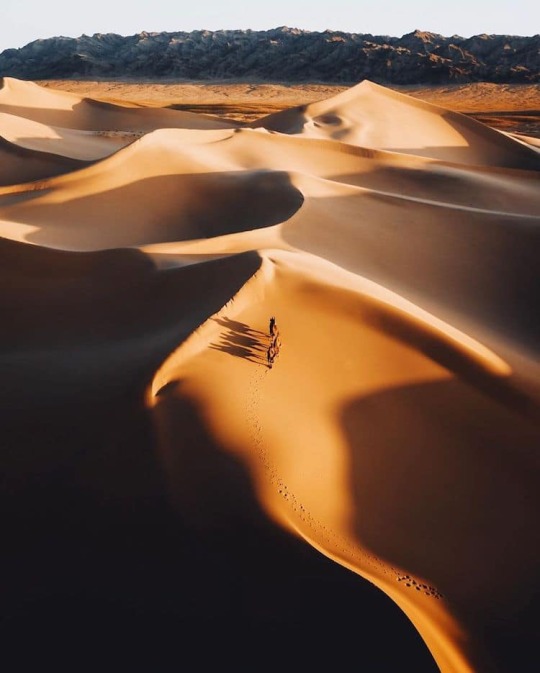
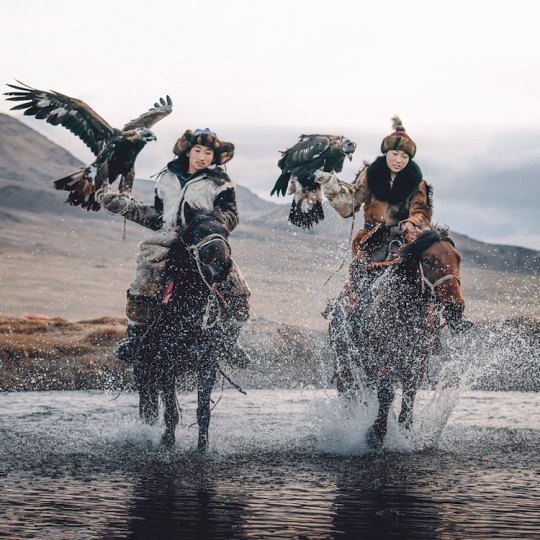
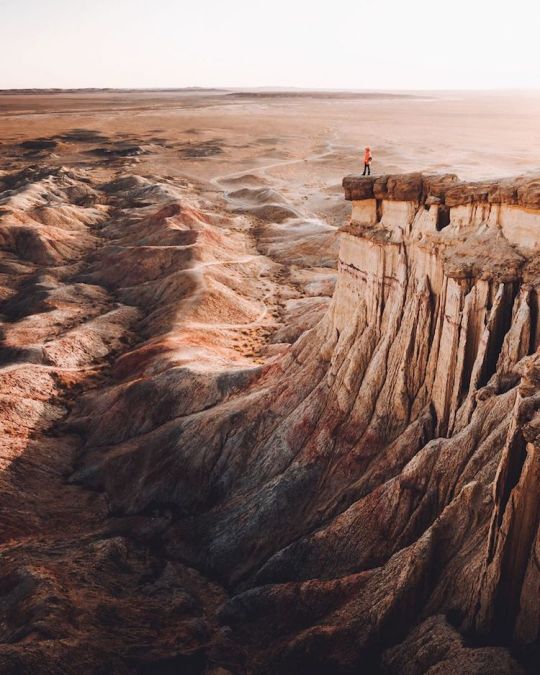

German photographer Leo Thomas recently visited Western Mongolia’s Altai region to capture the lives of traditional eagle hunters
https://mymodernmet.com/mongolian-eagle-hunters/
#mongolia#eagle hunters#mongols#altai#siberia#world culture#leo thomas#travel mongolia#eagle#travel#mu#mu photo#10 photo#10 notes
15 notes
·
View notes
Text
I wonder how they feel about training foreigners? They seem to run the AK or VZ 58 so not much of a learning curve there.
16 notes
·
View notes
Text
okay i am making you guys hear my character fursona opinions.
xl: otter!!!! specifically an asian small-clawed otter. small, fluffy, highly social and intelligent. plus, look at them:

hc: i know people say he’s a fox but i have to disagree, i think he’s a maned wolf. weird, lanky proportions, tall, very handsome, and red. generally solitary, but they form monogamous pairs.
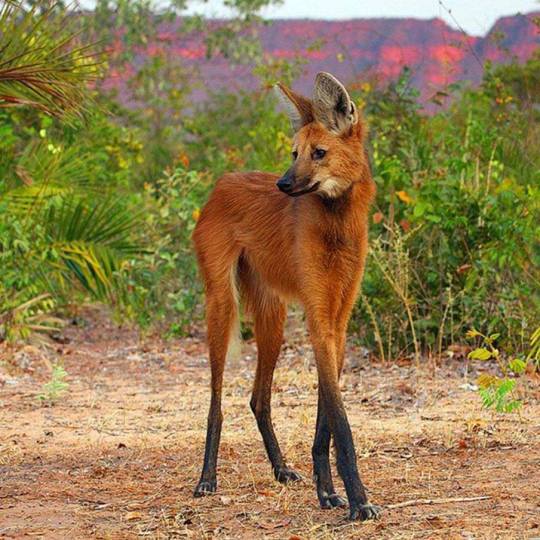
mq: shrike. i am obsessed with these birds honestly, they’re so fucked up and i love them. tiny, deadly, beautiful. what can’t they do?

fx: honestly it’s a tossup between a mongolian wolf and a stellar’s sea eagle, with a heavier lean towards the eagle. they’re big, they look kind of ridiculous, and they’re very good hunters. on the other hand, something something dog metaphors, so do with that what you will.


sqx: victoria crowned pigeon. need i say more?

hx: long-tailed widow bird. black, has a horrifically ironic name, very regal but unfortunately outshined by the victoria crowned pigeon’s colouration.

lxc: tiger!!! elegant and deadly. i would put him as a dragon but unfortunately i think that is a bit overused and also they are unfortunately not real. tigers, i figure, are close enough, and they’re good luck.

jgy: chinese water deer! i don’t have a deeper reason for this, i just think that a generally peaceful animal who also has giant tusks is a nice fit for him visually.

2 notes
·
View notes
Text




Zamanbol and her brother Barzabai, Mongolian eagle hunters, photographed by Leo Thomas
Source
0 notes
Text
Embark on an Authentic Mongolian Eagle Hunting Adventure Today

# Embark on an Authentic Mongolian Eagle Hunting Adventure Today
Introduction
Have you ever dreamt of witnessing the awe-inspiring sight of majestic eagles soaring through the vast Mongolian skies? Imagine being part of a centuries-old tradition where hunters form an unbreakable bond with these revered birds of prey. Mongolia Eagle Hunting Tours offers a unique opportunity to delve into the rich cultural heritage of Mongolia and experience the ancient art of eagle hunting firsthand.This blog post will take you on a journey through the captivating world of Mongolia Eagle Hunting Tours, exploring the deep-rooted traditions, breathtaking landscapes, and the unparalleled bond between hunter and eagle.
The History and Significance of Eagle Hunting in Mongolia
Eagle hunting, also known as berkutchi, has been an integral part of Mongolian culture for over 4,000 years. Here are some key insights into the history and significance of this ancient practice:Origins of Eagle Hunting- Dating back to the time of Genghis Khan, eagle hunting was initially used for hunting prey and protecting livestock. - The Kazakh nomads of Western Mongolia have preserved and passed down the tradition through generations, forging a unique bond with the majestic golden eagles. - Eagle hunting symbolizes the harmonious relationship between humans and nature, reflecting the nomadic way of life in Mongolia. - The skill and bravery required for eagle hunting have elevated the hunters to the status of revered figures in Mongolian society. - Witness the traditional eagle training methods passed down through generations. - Explore the stunning Altai Mountains and vast open steppes of Mongolia. - Immerse yourself in the nomadic lifestyle by staying in traditional ger camps. - Your tour will be led by experienced guides and seasoned eagle hunters who will offer insights into the history and techniques of eagle hunting. - Expert handlers will showcase the bond between the hunters and their eagles, highlighting the mutual trust and respect that defines this unique relationship. - Responsible and sustainable tourism practices are integral to Mongolia Eagle Hunting Tours, ensuring the preservation of wildlife and habitats. - By participating in these tours, you contribute to the conservation of golden eagles and the cultural heritage of Mongolia. - Research reputable tour operators that specialize in eagle hunting tours and have a strong commitment to cultural preservation. - Read reviews and testimonials from previous travelers to ensure a positive and authentic experience. - Pack appropriate clothing for varying weather conditions, including warm layers for cold nights and sturdy shoes for outdoor activities. - Bring a high-quality camera to capture the stunning landscapes and memorable moments during your tour. - Respect the traditions and customs of the local communities by seeking permission before taking photographs and participating in cultural activities. - Engage with your guides and hosts to learn about the history and significance of eagle hunting in Mongolia. - Stay updated on travel advisories and local regulations to ensure a safe and enjoyable journey. - Familiarize yourself with basic Mongolian phrases to communicate effectively with locals and enhance your cultural immersion. - Participate in hands-on activities such as eagle training sessions and traditional games to deepen your understanding of Mongolian culture. - Take time to connect with local communities and learn about their way of life to gain a holistic perspective of the region. - Be prepared for the rugged terrain and remote locations during your tour, keeping an open mind and a spirit of adventure. - Embrace the simplicity of nomadic living and appreciate the beauty of the natural world surrounding you. - Reality: Eagle hunting in Mongolia is a well-regulated tradition that emphasizes the welfare of both the eagles and the hunters. The bond between the eagle and its handler is built on trust and mutual respect. - Reality: Responsible tour operators prioritize conservation efforts and ethical practices to ensure the long-term sustainability of eagle hunting traditions. Participants engage in educational experiences that promote wildlife protection. - Reality: Mongolia Eagle Hunting Tours offer authentic cultural experiences that provide insight into the centuries-old traditions of the Kazakh nomads. The immersive nature of these tours allows travelers to witness the genuine bond between hunters and eagles.
Conclusion
Embarking on a Mongolia Eagle Hunting Tour is not just a journey through stunning landscapes and ancient traditions; it is a transformative experience that immerses you in the heart of Mongolian culture. From the rugged beauty of the Altai Mountains to the exhilarating displays of eagle hunting prowess, this adventure offers a rare glimpse into a way of life that has stood the test of time.As you plan your Mongolia Eagle Hunting Tour, remember to approach this experience with an open heart and a thirst for discovery. The bond between hunter and eagle transcends language barriers and cultural differences, illustrating the universal connection between humans and nature.Take the first step towards your Mongolia Eagle Hunting Adventure today and witness the magic of this timeless tradition unfold before your eyes.
Frequently Asked Questions
Q: Are Mongolia Eagle Hunting Tours suitable for all ages? A: Mongolia Eagle Hunting Tours are generally suitable for all ages, but it is essential to check with tour operators regarding specific age restrictions and suitability for children.Q: Is eagle hunting still practiced as a means of livelihood in Mongolia? A: While eagle hunting has evolved from a practical hunting method to a cultural tradition, some Kazakh nomads in Western Mongolia continue to practice it as a means of livelihood.Q: How can I support the conservation efforts associated with eagle hunting in Mongolia? A: You can support conservation efforts by choosing Mongolia Eagle Hunting Tours that prioritize wildlife protection, minimizing environmental impact, and contributing to local communities' sustainable development.Q: What is the best time of year to embark on a Mongolia Eagle Hunting Tour? A: The best time to experience Mongolia Eagle Hunting Tours is during the winter months when the eagle hunting festivals take place, offering a vibrant display of traditional skills and cultural celebrations.Q: Can I interact with the eagles during a Mongolia Eagle Hunting Tour? A: Some Mongolia Eagle Hunting Tours offer hands-on experiences where participants can interact with the eagles under the guidance of expert handlers, gaining a deeper understanding of the bond between hunter and bird of prey.
Tags
Mongolia Eagle Hunting Tours, Eagle hunting in Mongolia, Kazakh nomads, Cultural heritage, Altai Mountains, Sustainable tourism, Conservation, Nomadic lifestyle, Authenticity Read the full article
0 notes
Text
World Nomad Games: A Grand Showcase of Central Asian Traditions

The fifth edition of the World Nomad Games has begun in Astana, Kazakhstan, celebrating the rich cultural heritage and traditional sports of Central Asia. Known as the "Great Gathering on the Steppe," this event brings together diverse communities from across inner Asia to showcase a unique blend of ancient sports, cultural practices, and traditional artistry.
Often likened to a fusion of the Highland Games and the Mongolian Naadam festival, the World Nomad Games offer a glimpse into what the Olympics might have looked like under Genghis Khan’s reign. The games feature a variety of traditional sports, including horseback wrestling and strongman competitions, alongside a vibrant display of Kazakh food, attire, and epic storytelling. The event aims to preserve and promote the nomadic culture that faces threats from modernization, globalization, and climate change.
Held every two years in different locations, the World Nomad Games' next edition in 2026 is expected to return to Kyrgyzstan, the site of the inaugural event in 2014. This year's festivities will conclude on September 13.
A Stunning Opening Ceremony The opening ceremony on September 8 was a dazzling spectacle, with 3,000 athletes from 89 countries parading before an audience of Central Asia’s political elite. The performance traced the history of the Kazakh steppe from ancient Scythian warriors to the rise of the Golden Horde and the Kazakh khanate. The arena was transformed into a symbolic yurt, echoing the traditional gatherings of nomadic confederations.
The Thrill of Kokpar One of the most exhilarating events is kokpar (also known as kok buru, ulak tartysh, or buzkashi), a sport akin to rugby on horseback but with a headless goat carcass as the ball. The game is fiercely competitive, often resulting in injuries as players vie to secure the carcass and score by placing it in a ring. The Kazakh team emerged victorious against Kyrgyzstan in a dramatic final, watched by thousands.
Preserving Traditional Eagle Hunting Hunting with eagles is another highlight, though it’s one of the most endangered sports featured. Skilled eagle hunters (berkutchi) from Kyrgyzstan, Kazakhstan, and Mongolia showcase their ability to train golden eagles for hunting foxes, rabbits, and wolves. This ancient practice is deeply rooted in the region's culture and requires years of training.
Horseback Wrestling and More Horseback wrestling (audaryspak) is a central sport, taking place in a 15-meter arena with bouts divided into weight categories. The objective is to unseat the opponent from their horse or push them out of the circle. Other wrestling styles include Kazakh, Turkish, Tatar, and Kyrgyz variations, many of which feature female competitors.
Archery, both on foot and horseback, remains a poignant reminder of Central Asia's warrior heritage, while mas-wrestling, a form of stick tug-of-war from Yakutiya, offers a unique and engaging competition.
Celebrating Nomadic Culture The World Nomad Games go beyond sports to celebrate nomadic culture. The Ethno-aul, a village of yurts, craft shops, and eateries, hosts reenactments and performances of traditional music and folklore. Noteworthy among these are the akim, bards who perform epic poetry accompanied by the dombra, a traditional Kazakh lute.
Preserving Artistry The Games also emphasize traditional crafts. Master artisans, like Bulbul Kapkyzy, showcase skills in weaving, yurt-making, and other traditional crafts. Kapkyzy, a Kazakh from Mongolia, has dedicated over 45 years to preserving these arts.
Astana’s Modern Backdrop Astana's futuristic architecture contrasts with the ancient traditions celebrated at the Games. Known for its cutting-edge design by architects like Norman Foster, the city stands as a modern marvel on the steppe, even though it is one of the coldest capitals in the world.
The World Nomad Games not only highlight the rich heritage of Central Asia but also bring together a global audience to appreciate and celebrate a vibrant, living tradition.
0 notes
Text
Journey Through the Heart of Mongolia: Exclusive Tour Packages and Altai Mountain Adventures
Nestled between vast steppes and towering mountains, Mongolia remains one of the last bastions of untouched wilderness and ancient nomadic culture on Earth. For the intrepid traveler, Mongolia offers a stark contrast to the familiar, a place where adventure is woven into the fabric of the landscape. Through a variety of Mongolia Tour Packages and the Mongolia Altai Mountain Tour, visitors have the unique opportunity to explore this rugged land in-depth, experiencing its natural wonders and the enduring traditions of its people.

Cultural Insights and Historical Explorations
The best Mongolia Tour Packages delve into the rich tapestry of Mongolian history and culture. Visitors can wander through the ruins of Karakorum, the ancient capital of the Mongol Empire, or experience the spiritual tranquility of Buddhist monasteries that dot the landscape. These tours not only illuminate Mongolia’s glorious past but also bring travelers face-to-face with the vibrant cultural traditions that are still alive today. From witnessing the incredible skill of eagle hunters to participating in the daily lives of nomadic herders, these experiences provide a profound understanding of the enduring Mongolian way of life.
Introducing the Mongolia Altai Mountain Tour
For those drawn to the call of the mountains, the Mongolia Altai Mountain Tour offers an unforgettable adventure. The Altai Mountains, a majestic range stretching across the western part of Mongolia, are known for their rugged beauty and the diverse ecosystems they encompass. This tour is a dream come true for hikers, nature lovers, and photographers alike, offering breathtaking landscapes from glacial peaks to rich, verdant valleys teeming with wildlife.
Adventures in the Altai Mountains
The Mongolia Altai Mountain Tour is more than just a trek; it is an expedition into the heart of Mongolia’s wilderness. Participants get the chance to traverse remote paths, camp under the stars, and observe rare wildlife species in their natural habitats. The physical challenge of hiking through the Altai is rewarded with panoramic views and the serenity of untouched nature. This tour not only challenges the body but also enriches the soul, offering deep, reflective experiences amidst some of the most spectacular scenery on the planet.
Connecting with Mongolia's Landscape and Legacy
Both the Mongolia Tour Packages and the Mongolia Altai Mountain Tour offer gateways to understanding Mongolia’s complex tapestry of history, culture, and natural beauty. These tours provide a broad spectrum of experiences that highlight both the ancient traditions and the majestic landscapes of Mongolia. They invite travelers to not just see Mongolia but to engage with it, offering deeper insights and lasting memories.
Conclusion
Mongolia is a land of diversity and contrasts, where ancient traditions meet breathtaking landscapes. Whether it’s through the expansive Mongolia Tour Packages or the focused Mongolia Altai Mountain Tour, there are endless opportunities to explore and connect with this unique country. For those ready to embark on a journey of discovery, further details and booking information can be found at westernaltai.com, your guide to the wonders of Mongolia.
0 notes
Text

Places Where You Can Experience Mongolian Eagle Hunters
For an unforgettable cultural journey in Asia, a visit to Mongolian eagle hunters is a must. Rooted in centuries-old traditions among the nomadic Kazakh tribes in western Mongolia, eagle hunting offers a unique experience. Explore destinations to witness and immerse yourself in the world of Mongolian Eagle hunters. Discover more!
0 notes
Text
Day Tour to Mongolia: Experience the Best of the Land of Blue Skies
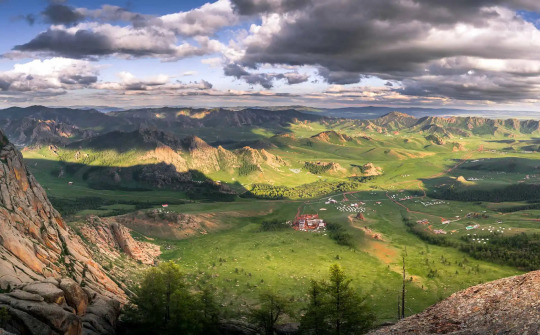
Mongolia, the land of blue skies, is a country that boasts stunning landscapes, vibrant culture, and friendly people. Mongolia has something for everyone, from the vast Gobi desert to the snow-capped Altai Mountains. A day tour to Mongolia is the perfect way to experience the best of this incredible country in a short period. This article will guide you through everything you need to know about a day tour to Mongolia, from the best places to visit to what to expect during your trip
Discovering the Best of Mongolia in a Day
Top Destinations to Visit on a Day Tours to Mongolia
Exploring the Gobi Desert on a Day Tour
A Glimpse of Mongolia's Nomadic Culture
Taste Mongolia's Unique Cuisine
Discovering the Best of Mongolia in a Day
A day tour is perfect for those short on time who want to experience Mongolia's beauty.
On a day tour, you can explore the country's diverse landscapes, vibrant culture, and friendly people.
The best time to visit Mongolia is during the summer months of June to August.
Top Destinations to Visit on a Day Tour to Mongolia
Ulaanbaatar City Tour: Visit the capital city and witness the blend of modern and traditional architecture.
Terelj National Park: Explore the stunning natural beauty of this park with breathtaking views of rocky formations and alpine forests.
Chinggis Khaan Statue Complex: Marvel at the towering statue of the legendary warrior and founder of the Mongol Empire.
Hustai National Park: Witness the wild horses roaming free in the open grasslands.
Exploring the Gobi Desert on a Day Tour
Yol Valley National Park: Take a hike in the picturesque valley and spot various wildlife species.
Khongor Sand Dunes: Ride a camel on the world's largest sand dunes and watch the sunset over the vast desert landscape.
Bayanzag Flaming Cliffs: Explore the site where the first dinosaur eggs were discovered.
A Glimpse of Mongolia's Nomadic Culture
Mongolian Ger Camp: Experience traditional nomadic life by staying in a Ger, a portable dwelling, and witness the local customs and traditions.
Horse Riding Experience: Go horseback and explore the countryside like a nomad.
Eagle Hunter Experience: Learn the ancient art of eagle hunting from a skilled hunter and watch as they train their eagle to hunt.
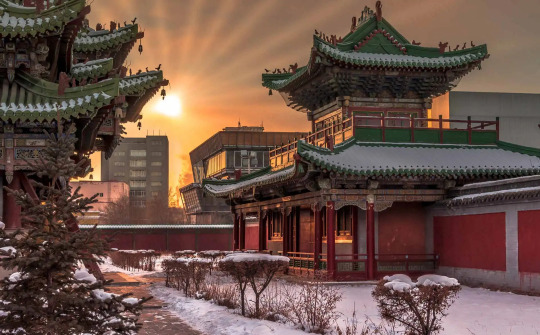
Taste Mongolia's Unique Cuisine
Buuz: Try the steamed dumplings filled with meat, onion, and garlic, a staple in Mongolian cuisine.
Khorkhog: Savor the Mongolian barbecue made with lamb or goat, cooked with hot stones and seasoned with vegetables.
Airag: Taste the fermented mare's milk, a traditional Mongolian drink with a slightly sour taste.
Mongolian cuisine is hearty and flavorful due to its nomadic roots. During your day tour, make sure to sample some traditional dishes such as khorkhog (meat cooked with hot stones), buuz (steamed dumplings filled with meat) or boodog (meat roasted inside an animal skin). It's a unique culinary experience that will leave your taste buds longing for more.
If you're lucky enough, your day tour might coincide with one of Mongolia's famous festivals like Naadam or Tsagaan Sar which marks the Lunar New Year celebration. This is an excellent opportunity for visitors to witness colorful parades, wrestling matches or cultural performances.
Conclusion
A day tour of Mongolia is an excellent way to experience the best of the country's diverse landscapes, rich culture, and friendly people. Whether exploring Ulaanbaatar's vibrant city life, hiking in Terelj National Park, riding a camel in the Gobi Desert, or tasting the unique Mongolian cuisine, this tour will leave you spellbound. With so much to see and do, a day tour to Mongolia is an adventure you won't forget.
A day tour to Mongolia is an incredible way to delve into a new world full of surprises waiting to be discovered by those bold enough to travel outside their comfort zone. So pack your bags and embrace this unique adventure that awaits!
1 note
·
View note
Photo

23 notes
·
View notes
Photo


Spellcaster is a series I’m working on exploring the theme of powerful women in nature surrounded by colour. The first in the series, Red Witch is based off the Mongolian eagle hunters who train raptors to hunt small game. I intend to create diverse scenes that will see me extending my reach with backgrounds, focusing on texture and different hues of intense saturation.
#mayticks#art#lgbt artists on tumblr#lgbt artist#queer artist#series#project#strong women#women united#women in colour#red#hues#mongolian eagle hunters#huntress#witch#raptor#texture#2018 june#spellcaster
129 notes
·
View notes
Text
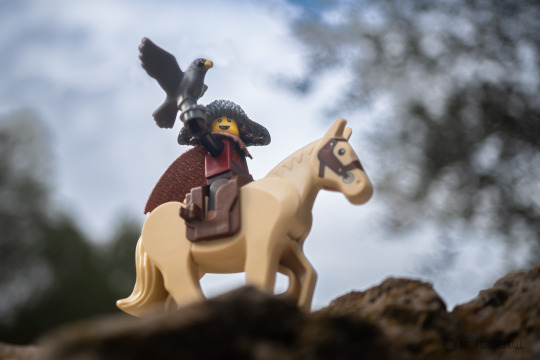
70% there
This photo is far from perfect. In fact, it's just a test shot to see if I could get enough sky at this angle with my mirrorless camera and if it looked too weird having these trees in there.
During the planning phase, I knew I would have to change the arm to a third-party one so the falcon wouldn't hit my character's hat or obscure his face.
I tried this several months ago with the eagle part but that was an absolute no-go. Look at that wingspan compared to the falcon's!
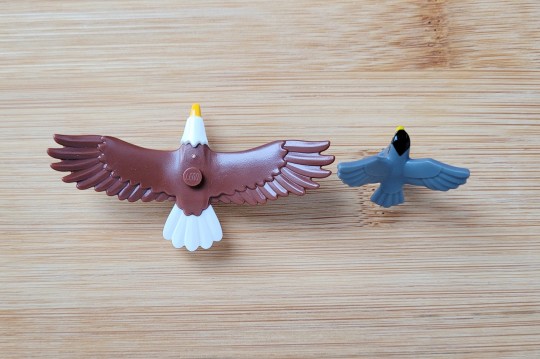
The new falcon (available in CMF 24) has its wings up and they're much shorter, so it's easier to work with for this concept at least.
I tried the "victory" arm from Crazy Bricks first, but saw that meant the falcon would also be attached at a weird angle. So I went with the older horizontal arm version.
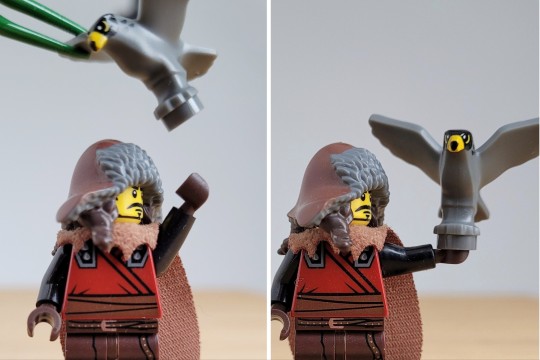
I know lots of LEGO photographers hate Crazy Arms in particular-- it's too much of a departure and some charm is lost-- but I'm not too bothered if it's just one change that's not super obvious.
I mean, it's obvious in the above photos but not in the final photo I envisioned.
And that final photo was something like this:
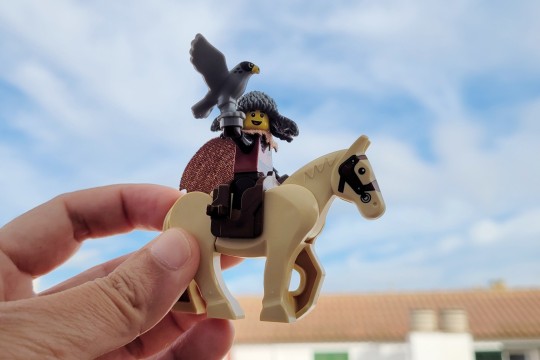
A nice sky with a landscape with mountains in the distance or open field.
That's just a shot with my window open and taken with my phone. Nice day, right?
And so we come to the boulder I found. I balanced the horse on it to see if it was a suitable spot and took a quick shot with my phone:
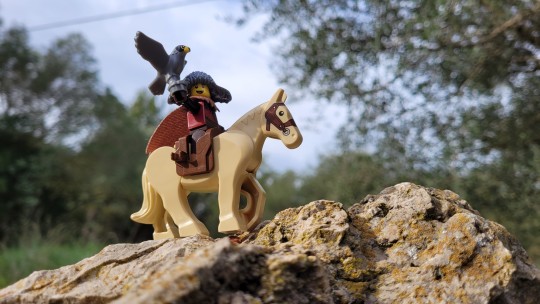
I liked this rock, but it didn't look like I'd have enough clear sky with those trees and power lines. I'd probably have to move on to a different location.
But just to check, I took a couple of shots with my dedicated camera in my hands. Then suddenly the wind picked up and it started to rain.
I packed up and went home right away.
When I looked at the test photos on the computer, I saw that I got the angle, pose, and kind of rock I wanted but I missed the open sky and deeper depth of field.
But it's nearly there, and I'll take that for today. It's my win, my fulfillment, even if it's a bit short of my vision.
Tomorrow's another day and fingers crossed I can find a location that works and that the weather cooperates.
31 notes
·
View notes
Photo

Photographer [Leo Thomas] Captures One of the Last Female Eagle Hunters of Mongolia
240 notes
·
View notes